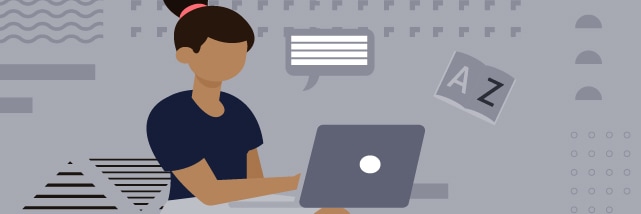So you have a transcription project but have no idea where to start? Maybe the best point to begin is knowing the basics of transcription. What will be expected at the end of your project? What is the best transcription format for the public?
As you will notice, each transcript is different. For instance, an interview transcript looks different from a transcript for a podcast or conference. The expectation is that from the format you choose, a reader can tell the kind of audio file you were transcribing.
The basic understanding of transcription is converting audio into text or convert video to written text.
Then why are we even talking about a format?
To answer the question, see what makes a format best for a transcription project.
What Makes the Best Transcription Format?
The format is important because the reader who ends up with your transcripts does not enjoy the benefit of listening to the audio file. As such, the information on the transcript should be easy to follow and extract.
Thus, consider the following basic requirements for a transcription format to boost the quality of your transcripts.
1. Consistency
The transcripts should adopt a consistent format from the beginning to the end. Format changes will be confusing to readers and could lead to loss of information placed at another spot. For instance, a name used for one speaker during an interview should remain at the end. Another element is timestamping, whereby the duration is maintained.
Some audio files feature varying content. For instance, an interview may form a part of research narration or presentation. Therefore, indicate the changes in your transcript such that the reader knows what to expect.
The bottom line is a format that remains consistent and predictable to the end of the project. The reader will easily follow the content of your transcript.
2. Fit for the Purpose
Why are you preparing the transcripts? Are they to be used for a research paper? Will they help the client to add captions to a video? Are you creating a document for attachment to official files? Is it an article to be uploaded online as part of a digital marketing campaign?
Each of these and many other scenarios demand a different type of transcript.
Client instructions should indicate the purpose of transcription. This purpose determines whether you will have a verbatim transcription or have to edit the transcripts.
At the end of the day, the transcripts should help the client to achieve his goals.
3. Client’s Preferences
Clients have different preferences based on the aim of ordering the transcription. In some cases, clients want a verbatim transcript that captures all details. In other instances, off-the-curve remarks and background noises are to be ignored.
It is this preference that makes a transcript unique and satisfactory. In discussing the priorities, the transcriptionist guides the client on the best choices to make. In other cases, the client tweaks the idea a transcriptionist has to achieve a particular goal.
When all is said and done, the transcript belongs to the client and must meet their desired standards.
Basic Rules for Transcription Formatting
Transcription goes beyond converting audio files into text. Even before you write the first word, some rules should ring in your mind so that the transcripts you produce are acceptable.
Remember that as a transcription specialist, your trade is different from many other writing specialties. Again, these rules apply whether the client has provided express instructions or not.
· Choose One Format
Each transcript is so unique that it will never call for a combination of formats. An interview transcript, for example, will never appear like a podcast or YouTube transcript.
How do you know the format to choose?
Well, review the instructions provided by the client. These instructions indicate the expectations at the end of your transcription project. Without clear instructions on the format, listen to the audio file to the end. It will give you an idea of the form to adapt.
· No Paraphrasing
Of course, unless the client wants you to paraphrase! Here is the point, transcription requires you to turn audio words into text. Paraphrasing means that you use other words to express the same idea.
Paraphrasing is risky because you might choose a word that does not represent the idea of the person speaking in the audio file.
Hence, stick to the words used by speakers in the audio files. You can only edit grammar or remove filler words on request.

· Capture Time Stamps
It is a requirement in most transcription projects. In most projects, you must indicate what was said and the time within the audio file when it was told.
Time stamping helps during review, editing, and captioning. If a person wants to follow dialogue or caption a particular section, he does not go through the entire audio file.
From the timestamps, he will jump directly to the selection of interest.
A Guide to Transcription Formatting
The term transcription formatting determines the eventual appearance of your transcripts. As discussed above, it depends on the audio file’s nature and the purpose for which transcription is happening.
Here is a detailed guide to transcription formatting that will apply to all transcription projects.
a) Style Requirements
The rules apply to primary as well as verbatim transcription.
- A bracket is used to indicate interruption during speech or dialogue. Also, it helps capture explanation or description. Moving forward, keep the story between 1-3 words. Some of the interruptions captured include background noise and silence. Special treatment is also given to the tone of speech. Use a bracket to indicate whether a person was angry, shouting, joking, and other tone variations.
- Show uncertainty about words. Use different types of brackets to indicate that you are uncertain about the words spoken. Moreover, do not misuse this provision because you will not be helping the client. Struggle to hear all the words accurately. The terms may be foreign, inaudible, or phonetically challenging.
- The average timestamp is 30 seconds during transcription. Some projects may require shorter time stamps, while others do not require any timestamps. Thus, provide the time stamps consistently for easier follow-up.
- Label all the speakers in the transcript. The rule is mandatory where dialogue is involved. Hence, provide a key at the beginning to identify all the people involved. Furthermore, use descriptive labels so that the reader does not have to search for the audio to understand the characters involved.
b) Basic Transcription Format
If everything heard in an audio file were captured in the transcript, it would be tedious to read. There are basic rules that boost the quality of your transcript and, in the process, help you to meet client’s expectations.
Here are a few such rules:
- Indicate persistent sounds once if they do not disrupt dialogue or the narration. For instance, you may encounter ‘typing throughout’ or the sound of AC. Indicate these occurrences at the beginning of your transcript.
- Remove filler words and statements from the final transcript. The uhms, yeah, mmh, and such filler words only make your transcripts cumbersome. The rule applies in all situations unless asked to make a verbatim transcription.
- Remove any conjunctions that start a sentence. Remember, your transcripts should be grammatically correct.
- Remove false sentence starts at the beginning of sentences. Audio recordings in real-life situations feature a lot of repetition and correction of sentences. Remove them from the final transcript. Of course, the rule will not apply during verbatim transcription.
Overall, stick to the most basic form of punctuation. A speaker will never indicate that you should use a colon or semicolon. As such, do not form grammatical elements where they do not exist.
c) Verbatim Transcription
This is the most basic form of transcription. The idea is to capture everything you hear in the audio file.
The sound events that do not disrupt dialogue are indicated whenever they occur. Whether it is typing, coughing or background noise, capture it in your transcript.
Therefore, retain the filler words and conjunctions beginning sentences. Even the false penalties must remain. In many cases, unique punctuations like colons and semicolons are useful.
Still, the standard rules of grammatical punctuation must be followed: It keeps your paper within a reasonable grammatical realm.
Where to Get the Best Transcription Formats
Having agreed that transcription is more than converting audio into text, a transcription format guide would make it easier to stick to the right format.
There are transcription format templates that will guide you when choosing a style for your project.
Here are the most reliable sources.
i) Request Your Client
A client has an idea of what he wants at the end of the project. Above anyone else, the client is the best source of a transcription format. It is at this point that clients indicate whether they need verbatim transcription or with some editing.
Clients will also provide samples of previous works to guide you. When an example or template comes from the client, the chances of conflict over formatting will reduce.
ii) Check from Top Transcription Platforms
The best transcription services online provide samples and templates to clients as well as transcribers. Because of the diversity of clients they serve, these transcription companies have a wide range of formats to choose from. Most of the samples are free unless you want an overly technical template.
iii) Follow the Audio File Format
The audio file will give you a natural guide on the format to use. This is why experts advise transcribers to first review an audio file before starting on transcription. You will hear whether there is dialogue, interview, or a narration, among other formats.
You may also begin with verbatim transcription and later format your transcripts.
iv) Adhere to Client Preferences
Clients make special requests when issuing transcription assignments. One may be interested in verbatim transcription for an interview, while another wants an edited version.
You may even be asked to extract an article from the audio file. Such preferences will guide you on the eventual format to adapt.
Conclusion on Transcription Formats
A transcript helps the client to achieve a particular goal. The role of the best transcribers is to help the client to achieve these goals.
While you follow the client’s instructions during the assignment’s issuance, you must use your expertise and experience to help the client achieve his or her goal.
Remember, templates and samples will help you to understand the best format for use during each project.
Get the most impressive transcription services at Bunny Studio. Enjoy experienced transcribers who understand different formats that will meet and exceed your expectations.
Here is to the best transcription experience; cheers!










